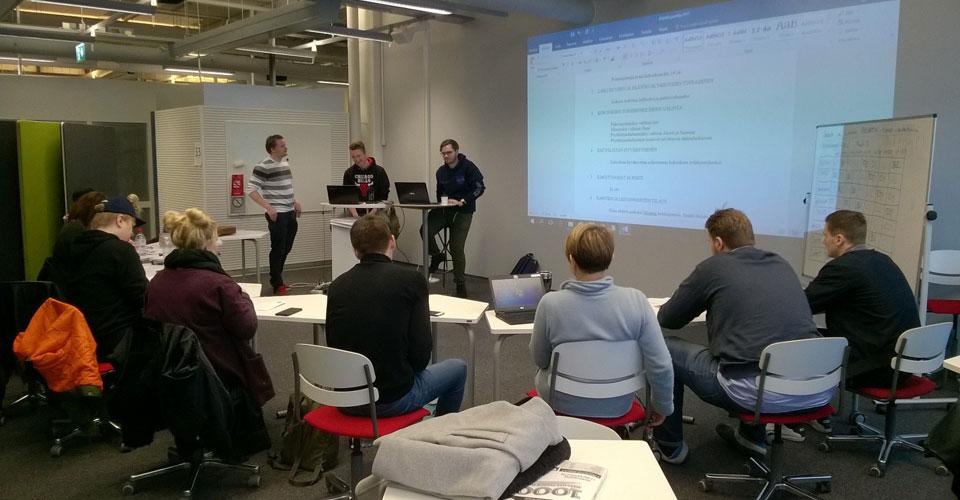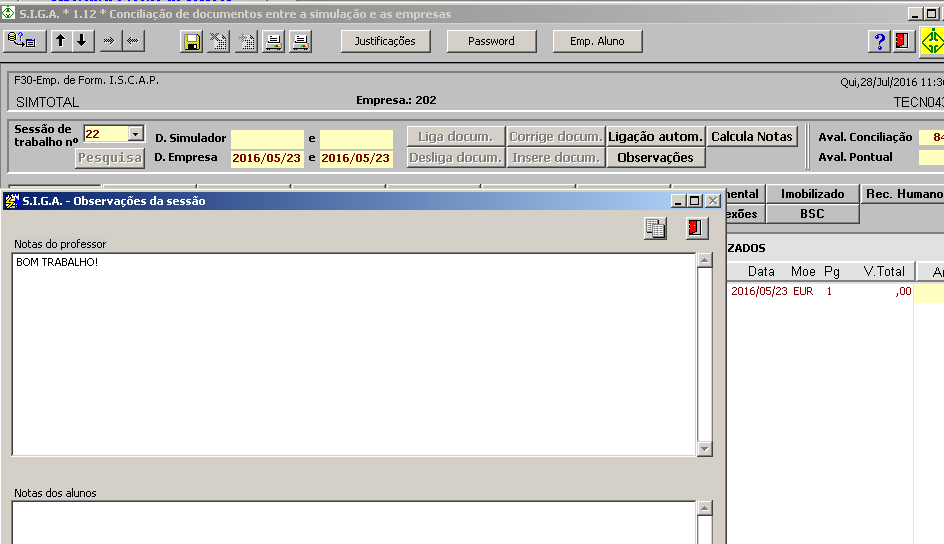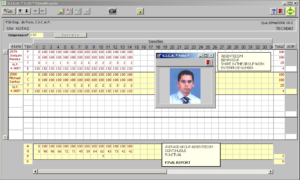
Authors: Susana Bastos, Kai Schleutker & Liliana Azevedo.
Abstract
Latest research indicates that business graduates are expected to possess soft skills in addition to their substance related hard skills. In working environments, soft skills are needed for communication and adaptation, as well as for employability reasons. For higher education institutes this means an increasing challenge.
Even if the need of soft skills is widely acknowledged, new efforts to build appropriate learning environments are needed continuously. Soft skills have been highlighted in social care and nursing education, whereas in business fields they have received less attention.
In this article, two learning environments for business studies at Universities of applied sciences are presented. The ISCAP (Porto) model bases on Business simulation, whereas the TUAS (Turku) model involves team-based learning. These learning environments have been designed particularly for fostering soft skills of the graduates, and thus implementing the idea of skills-based curriculum.
Background for the piloting of learning environments in business education at ISCAP and TUAS
European Commission enhances (EC 2017) the Higher Education Institutes (HEIs) to modernise their pedagogical methods in order to produce competencies and skills that are needed in the 21st century to cope with the increasing international competition. This statement (EC 2017) and multiple studies (e.g. McKinsey 2015; OECD 2016; WEF 2016) indicate that in addition to substance skills, HEI graduates are expected to possess soft skills (a.k.a. transversal skills) such as communication skills, team working skills, self-management skills and analytical skills.
At HEIs, this raises many questions. How should these intentions be implemented in business studies? What kinds of learning environments will help to form personal skills? In business faculties and degree programs, there are great diversities of specialisations – what kinds of personal skills will be needed in each of them?
The mission of universities of applied sciences is to act as innovators and dynamic actors in their own areas. In this article, we present two learning environments intended to cope better with the needs of the companies and produce soft skills. In the Polytechnic of Porto, Porto Accounting and Business School (ISCAP), the so-called Business Simulator bases on real tasks, feedback in real time, and in a new assessment methodology. At BisnesAkatemia in Turku University of Applied Sciences (TUAS), the team-based learning method and external assignments from companies are used as elements of learning environments.
Descriptions of the ISCAP and TUAS pilots
The Origin of ISCAP Model of Simulator of Business Environment
The Model of Simulator of Business Environment that supports learning is oriented to the development of some competencies that the students need in order to be prepared for the labour market.
The resource to the strategy of games/simulation of companies in certain curricular units may be useful. The SBE Model was created with the purpose that the complete training of competencies requires an availability of this Model that assures to the student a multifaceted participation, as an intervener agent in the process of conception, development and maintenance of the business reality (Rey 2002; Roldão 2003).
This Model of technological basis must propitiate a space of learning, based on the simulation of the organisational environment typical of an entity provided with an advanced management profile involving the student in the application of the knowledge that is emerging in a multi and inter-disciplinary form throughout the course.
The particularity of the skills training process that the Model is oriented to, shapes the teaching methodology and the assessment system itself, which is built on a dynamic basis primarily interested in the progressive effects of the expected change in students, but it is also concerned with the verification of the skills acquired having in consideration their final academic certification.
This practice of education and training has the fundamental purpose of linking theory to practice. Therefore, it requires turning the experience of training into professional experience, in which the passive and receiver role of the student gives place to an active role ‒ he is part of the process. (Azevedo 2012.)
Table 1. Skills to develop in students (adapted from Oliveira, L. 2018).| Vocational skills | Technical skills |
|---|---|
| Critical and analytical thinking | Use, with efficiency, of the communication and information technologies |
| Oral and written communication | Business decision modelling |
| Decision-making | Risk analysis |
| Continuous learning | Project management |
| Group work | Accounting in several branches |
| Professional behaviour (ethics and attitudes) | Negotiation |
| Leadership | Resources management |
| Entrepreneurship | Sales |
| Foreign language | Creation of the business plan |
| Economic and financial analysis |
The origin of TUAS BisnesAkatemia (BA) model
When asked from graduated, employers and business experts, it is widely agreed that the most prominent elements of business competencies are soft skills such as entrepreneurial mindset, communication and team-working skills, whereas profession related skills are mostly considered necessary but not crucial (Lehtinen 2006; Kotila 2012; Schleutker 2017). Some business environments, such as accounting and theory of law, might appreciate preciseness and by-the-book-knowledge, whereas in other business fields, such as entrepreneurship and marketing, the professional expertise mostly consists of personal dynamics and skills in communication, adaptation and innovation (Schleutker 2017).
This need of personal skills and the increasing diversity of working environments should be considered in curriculum planning. Even business learning environments should increasingly support development of personal competencies and skills.
For these reasons, the TUAS Business degree programme has been piloting an alternative learning environment called BisnesAkatemia (BA), which implements a skills-based curriculum instead of a mere substance-based curriculum.
To reach skills-based learning, personalised learning processes and adequate learning environments are needed (Sawyer 2006; Raiker 2009). Some fundamental conditions for personalised learning are individually-set goals, reflection of learning processes and meaningful learning assignments (Sawyer 2006). The BA learning environment aims to comprehend and facilitate these processes.
In the pedagogical aspect, the BA model includes features from several learning philosophies and methods. It is built partly on classical elements of Team Based Learning (Michaelsen 2006) and Senge´s Personal Mastery and Learning organization (Senge 2006), as well as recent inspirations from Innovation Pedagogy (Kettunen & al. 2013). The learning environment in BA involves fundamentally assignments from external organizations and companies, following the idea of Experiential Learning by John Dewey (Miettinen 2001). In order to achieve personalised learning and to reinforce soft skills, the students will need self-reflective and self-regulative skills (Zimmermann & Schunk 2011; Winne 2011).
Implementation
ISCAP Model of Business Simulation Project (BSP)
In the BSP model, the main pedagogical change of the teaching-learning process in business and accounting lies in creating the same pivot environment, which is available along all courses and personalised for each student. It is supported by real technological tools, coordinating the theoretical knowledge progressively acquired, in order to form comprehensive professional competencies (Roldão 2003).
The Model must be adopted, not only in the curricular units of Business Simulation Project (BSP), but also in all other curricular units framed in business sciences. These need a pivot environment to ensure the extent of knowledge to action in a common context, properly completed and evaluated.
BSP has as main goals (Oliveira 2003, 2018) targeting training to the most demanding and highest paid market demand. It aims to prepare professionals for more specialised functions, encourage the development of new skills; stimulate the capacity to structure, research and reorganise information in an integrated environment, and train and promote group and cooperative work. Further, it aims to enable the ability to make decisions, enrich communication skills, consolidate professional, personal and ethical attitudes, promote the electronic portfolio as the student’s curriculum essence, create and develop all the bureaucratic activities of a company in a systemic perspective and in a process-based approach, and continuously assess technical and behavioural performance. All this is supported by the Business Environment Simulator.
These BSP curricular units are optional. Students have the right to choose what suits them better and contributes to develop their personal competencies. They enter BSP in the last year and they can achieve 180 ECTS (European Credit Transfer System) in two semesters. These are learning environments allowing them to appropriate knowledge acquired in previous curricular units (Bastos 2016; Soares 2011). BSP are the first European curricular units to have a Certificate of Quality within ISO 9001:2015 and they are also recognised by the Portuguese Order of Certified Accountants as replacing the internship by the quality of its learning-teaching process.
TUAS BisnesAkatemia
The students enter the BA phase after having finished basic studies in business. They can gain 100‒120 ECTS in the BA learning environment, i.e. nearly 50 percent of their studies. These 100‒120 ECTS consist of smaller study units (5‒10 ECTS) representing main business topics such as enterprise planning & development, marketing operations, communication, organising events, innovative skills and domestic & international networking. The tray of study units is presented in table 2.
Table 2. Contents of studies in BA 2nd and 3rd year. (ECTS – European Credit Transfer System; ICT – Information and Communication Technologies. Created by Schleutker, K. 2018.)| Study units | Study units 5 ECTS | Study units 5-15 ECTS |
|---|---|---|
| 2nd year | 3rd year | |
| Enterprise developing operations | Start-up enterprise Develop an enterprise | Business Value through ICT |
| Marketing and sales operations | Business to business sales Productisation Product & Service Innovations Digital marketing | Modern Marketing and Selling |
| Innovative operations | Organising events Tools for innovating | Innovative business models |
| Networking | Domestic international networking International networking | --- |
At the end of the first year, business students enter the BA phase, where they will form their own 15‒20 person cooperative in order to conduct real-life business assignments with external organizations and companies. The division into the BA cooperatives is facilitated by interviews and tests in order to form a well-working team. One of the most important ones is the Belbin team role test (2018), which indicates what kinds of abilities and roles each one might bring to the team.
The following step is to organise the cooperative into a well-working team, capable of marketing, selling and carrying out real-life projects for customer companies and organizations. The tasks and goals of the projects typically relate to market and customer research, organising events, design and creation of websites and diverse Business-to-business or Business-to-customer customerships. This phase is indicative in many ways. It will show, how well the teaming process has proceeded and it also indicates to which grade the team possesses a shared vision, i.e. is it a team or just a group of students. Additionally, this phase shows whether there are sales-skilled students who take initiatives in the team. In a well-working team, there are the individuals who start to lead and who start to take actions. This is not something that can be counted on advance for sure.
In this kind of learning environment, the teachers´ role is very far from the role of the so-called traditional teachers. The teacher performing with a team is called a ‘coach’, and each team will have their named coach for the whole second and third year. Consequently, lectures are given only exceptionally in cases where a lecture is considered the best way of learning. Instead, teachers have an important role as facilitators of the team. In the starting period of BA, it is very much about facilitating a positive team spirit and constructive relationships between team members and encouraging to personalised learning and formation of individual soft skills.
In table 3, the main features of the learning environments BSP and Ba are presented.
Table 3. Main elements of learning environments in BSP and BA. (BA – BisnesAkatemia; BSP – Business Simulation Programme; CU – Curricular Unit. Created by Schleutker, K., Bastos, S. 2018.)| Description | ISCAP BSP | ISCAP (next stage) | TUAS BA |
|---|---|---|---|
| Purpose | Learning instrument to be made available at the PSE at the end of the course | Learning instrument to be made available in the various CUs of the business sciences, along the course | Learning environment to support development of personal skills |
| Context | Electronic database and multimedia room | Electronic database | Student cooperative |
| Organizing Principle | Systemic integration | Segmentation | Recruiting process |
| Represented object | Global market in electronic and physical format | Company / organization in electronic format | Real business operations with organizations and companies |
| Logical organization of phenomena | By process | By event | By decisions of team |
| Documentary format | Electronic and physical | Electronic | Electronic |
| Type of interaction | Intra and inter companies | Does not exist | Intra team, inter client companies |
| Responsibility for organization and planning | Teacher of the PSC CU | Course Direction | Curriculum planned by teachers; Operations planned by students |
| Student organization | In group | Individual | In group |
| Evaluation model | Continuous | Continuous | Portfolio assessment |
Assessment practices
ISCAP
Assessment is interpreted as a process of systematic collection of information to measure the students’ progress (self and peer evaluation) (Albrecht 1994; Albrecht & Sack 2000). It is continuous. Every class is evaluated – the teacher corrects all the tasks done by the groups. As there are two classes in a week, the teacher evaluates the first, so that in the second the students have the feedback in the system, in “real time”. This enables the student to understand and correct the mistakes. This feedback in registered in the system (Simulator). When the student opens his work session, he has access to it. This process allows the student to follow his teaching-learning progress (examples in figures below).


Teachers have an important role in this assessment process. They guide the students through their learning process.
The assessment of the degree of competencies acquired in the frequency of the curricular units based on the BSP Model follows an evaluation system supported in the feedback and in the obligation of execution, by the student, of the planned tasks, personally, and monitored by the teacher, in all the working sessions (Luckesi 2003).
Assessment is continuous, with feedback; with the complement of behavioral performance evaluation; based on a strong ethical component and in the attitudes of all participants; with the support of the electronic media involved; including those of the agents implicated, in charge of the student (Alarcão & Gil 2004; Costa & Candeias 2010; Raiker 2009).
TUAS
In order to facilitate personalised learning, the assessment is individual and well argumented for the student (Sawyer 2006; Raiker 2009). Thus, all assessment is based on an individual portfolio, in which the student describes the finished assignments, their main results and key learning notes. The student adds lessons learnt from books and articles during the study units. Thus reflection of own experiences, thoughts and development has been raised in a crucial role in the assessment. For many students, this can be quite demanding, especially for those ones not used to report and assess their own person and activity.
For the assessor, this kind of portfolio gives rather multiple bases to assessment. It makes visible the profession-related real-life tasks that the student has carried out. It also expresses what the student himself considers having learned. The level on which the student can combine the literature (theory) to what he has done (praxis) gives a good insight on the development of the student´s personal skills. In addition, it demonstrates in a clear way how well the theory is assimilated and adapted.
Regarding reporting and assessment of the development of personal skills (team working skills, communication skills, self-management skills, etc.), they are included in most plans of implementations and thus considered by the students when producing the portfolios.
Reflection: Positive outcomes
BSP – ISCAP
The students consider BSP as an active learning environment, which raises their motivation. The use of the electronic portfolio enables construction of the student’s curriculum in a way that is visible and informative for the student himself. In addition, the learning process is supported by an organizational environment of high systemic complexity, which is very close to authentic working life conditions. As a third positive outcome, the BSP provides immediate feedback and decision-oriented information, which enables improve the student´s learning.
BA – TUAS
The students favour the BA learning environment, primarily because most students seem to like the way of learning by doing. In addition, many students seem to like working in team.
As a positive outcome, students get experience of real-life assignments already during studies, which is appreciated by employers (Lehtinen 2006; Kotila 2012; Mourshed 2014). The learning environment enables holistic learning, where students have an option to develop both substance skills and their soft skills.
Students appreciate authentic assignments given by external companies as well – even if they might be more challenging than theoretical assignments. Moreover, the BA method including goal-oriented work teams and authentic tasks often provokes an uncomfort zone in individual students. Thus, it creates a need to learn and it motivates effectively personalized learning (Sawyer 2006; Raiker 2009) and the development of personal skills.
Challenges experienced
BSP – ISCAP
The teacher has a role of permanent support to the student, as it is a “relationship of peers”, and must, using new pedagogies and information and communication technologies suitable to the program content, instil in the student job autonomy and decision making, among other aspects. Thus, the curricular structure should be reconsidered and must rely on the basic formation of competencies, and must conceive education “always” adopting interdisciplinary and multidisciplinary and a systemic basis (Bastos 2016).
As methods and pedagogies pointed so that change happens, emphasis is on active learning methods, group work, “learning by doing”, and the motivation of the student by placing him in the centre of this whole process.
Thus, the assessment should be formative and not merely forming, having the need to assess the School and the teachers, “rewarding the most efficient” (Alarcão 2004).
BA – TUAS
Given that most students have a 12 years’ experience in structured and often teacher-guided way of studies, the change in student mindset demands effort. It seems that they are often more inclined to ‘teach-me’ more than ‘I-learn’.
Thus, the BA method is appropriate for students with self-steering abilities, but it seems not to suite all students.
Dynamics in teams varies according to persons and their characters, whereby some groups never become a real team. Others might have good chemistry of persons but the members will not step out their comfort zone. Finally there are the ones having both team and progress spirit, and consequently will get results.
In order to enhance learning of soft skills, it is important to mention those in the description of the study units, so that the students are aware of them. However, the assessment of these might be a challenge, since it should focus on personal behaviour in addition to the portfolio. Even giving constructive feedback to each student regarding these skills is demanding.
The coach’s role in this kind of learning environment is critical since it requires skills both in business and pedagogy.
Future considerations: both models
Considering the increasing need of skills such as team work, innovation and adaptation (Mourshed 2014; OECD 2016; WEF 2016), business students should possess these kinds of skills in order to proceed and give added value in the labour market. Therefore learning environments should be designed in a way enabling personalised learning and formation of these kinds of person-related skills.
As stated in this article, one of the main challenges regarding new learning environments is students´ mindset and their attitude towards them. They might assume a passive role if they have hesitations about the significance of the skills to be learned. Therefore it is highly important, that the whole faculty or even the whole University is engaged to the learning environment which is proposed.
At TUAS, all faculties will step by step adapt Innovative Pedagogy, the corner stones of which are Team working skills, innovative skills, networking skills and communication skills. These skills will starting from 2018 be embedded in all curricula in each faculty.
Considering future research, it is necessary to identify appropriate methods for assessing personal development and especially the formation of soft skills as well.
Conclusions of BSP and BA
Most involved parts in business life agree that business competencies comprehend increasingly personal skills such as communication, innovation and teamwork. Thus, one challenge in the higher education is to create learning environments that enable the formation of personal development. In this process, known as personalised learning, the student is expected to take an active role. One of the main challenges is whether students are willing/prepared to take the active role needed in personalised learning. Thus, the coaches’ feedback and assessment must be continuous and constructive.
The description and comparison presented in this article confirm that many possibilities are available in order to facilitate personalised learning the formation of soft skills. Most of the students get inspired of new learning methods, mostly because these models give them an option to learn in a more diverse way. The teamwork included in the learning environments is apt to increase team working skills, as well as communication skills. Assignments given directly by companies, or closely related to companies, will give the students more skills regarding adaptation, flexibility and decision making. In order to develop students’ soft skills, further study is needed on the impact of the learning environments upon the students´ abilities and skills.
Authors
Susana Bastos, Senior Lecturer, Porto Accounting and Business School (ISCAP), Polytechnic Institute of Porto (IPP), Centre for Organizational and Social Studies of P. Porto (CEOS.PP), Portugal
Kai Schleutker, Lecturer, Team coach (Innovative Entrepreneurship & Digital Marketing),
University of Applied Sciences of Turku – Faculty of Business and Engineering
Liliana Azevedo, PhD (Ed.) (Didactics and Technology of Education), Expandindústria, Portugal
[vc_tta_accordion active_section=”0″ no_fill=”true” el_class=”lahteet”][vc_tta_section title=”References” tab_id=”1458134585005-b3f22396-5506″]
Abrecht, R. (1994). Avaliação Formativa. Porto: Edições ASA. (In Portuguese.)
Alarcão, I., & Gil, V. (2004). Teaching and Learning in Higher Education in Portugal: Overview of studies in ICHED. Aveiro: Universidade de Aveiro.
Albrecht, S. W., & Sack, R. J. (2000). Accounting Education: Charting the Course through a Perilous Future (Vol. n.º 16). E.U.A.
Azevedo, L. (2012). Avaliação das aprendizagens no Ensino Superior: estudo de um sistema de avaliação nas Unidades Curriculares de Projeto de Simulação Empresarial. Aveiro: Universidade de Aveiro. (In Portuguese.)
Bastos, S., Azevedo, L., & Oliveira, L. (2016). Desafios à Escola Superior: metodologia inovadora em AE. Simulador do Ambiente Empresarial de base tecnológica. Novas Edições Académicas. Verlaag Editions. Germany. (In Portuguese.)
Belbin Team Roles. http://www.belbin.com/about/belbin-team-roles/ (visited 29.5.2018)
Costa, N., Martins, I., & Candeias, I. (2010). A avaliação e regulação de desempenho profissional (Vol. Colecção Situações de Formação). Aveiro: Universidade de Aveiro. (In Portuguese.)
European Commission EC (2017). An agenda for modernization higher education.
https://ec.europa.eu/info/law/better-regulation/initiatives/ares-2017-1062784_en
Guillén, D. G. (2011). La cuestión del valor. Madrid: Real Academia de Ciencias Morales y Políticas.
Kettunen, J., Kairisto-Mertanen, L. & Penttilä, T. (2013). Innovation pedagogy and desired learning outcomes in higher education. On the Horizon, Vol. 21 Issue: 4, pp. 333‒342. (In Finnish.)
Kotila, H. (2012). Oppimiskäsitykset ja oppiminen ammattikorkeakoulujen toimintaympäristöissä. In Kotila, H. & Mäki, K. (eds.) Ammattikorkeakoulupedagogiikka 2. Edita: Helsinki, 26‒34. (In Finnish.)
Lehtinen, U. (2006). Ilmiö nimeltä liiketoimintaosaaminen. In Lehtinen, U. & Mittilä, T. (eds.) Liiketoimintaosaaminen kilpailukykymme keskiössä. Jyväskylä: Kauppatieteellinen yhdistys. (In Finnish.)
Luckesi, C. (2003). Avaliação da aprendizagem na escola. Reelaborando conceitos e recriando a prática. Salvador: Malabares Comunicação e Eventos. (In Portuguese.)
Mourshed, M., Patel, J., & Suder, K. (2014). Education to Employment: Getting Europe´s Youth into Work. McKinsey Centre for Government.
OECD (2016). Getting skills right: Assessing and anticipating changing skill needs.
Oliveira, L. (2003). Projecto de Modernização do Ensino Superior da Contabilidade e da Gestão – PECRESC. (In Portuguese.)
Oliveira, L. (2018). O Ambiente Empresarial Simulado: Proposta de um novo curso superior de Contabilidade inspirado nesta nova metodologia didática. Aveiro: Universidade de Aveiro. (In Portuguese.)
Ospina, W. (1994). Es tarde para em hombre. Barcelona: Belacqua. (In Portuguese.)
Raiker, A. (2009). A personalized approach to improving students´ learning outcomes. In Nygaard, C., Holtham, C. & Courtney, N. (eds.) Improving students´ learning outcomes. Copenhagen: Copenhagen business school press, 49‒64.
Rey, B. (2002). As Competências Transversais em questão. Porto Alegre: Artmed Editora. (In Portuguese.)
Roldão, M. C. (2003). Gestão do Currículo e Avaliação de Competências – As questões dos professores. Lisboa: Editorial Presença. (In Portuguese.)
Schleutker, K. (2017). Yksilötason liiketoimintaosaamisen määrittelyä ja liiketalouden opiskelijoiden oppimisen taustalla vaikuttavista tekijöistä ammattikorkeakoulutuksessa. Master’s Thesis. Tampere: University of Tampere. (In Finnish.)
Senge, P. (2006). The fifth Discipline: The Art and Practice of the Learning organization. New York: Doubleday cop.
Soares, S. (2011). O Ambiente Empresarial de base Tecnológica na Formação de Competências. Aveiro: Universidade de Aveiro. (In Portuguese.)
Winne, P. (2011). A cognitive and metacognitive Analysis of self-regulated Learning. In Zimmermann, B. & Schunk, D. (eds.) Handbook of Self-Regulation and Performance, ss. 15-32. New York: Routledge.
World Economic Forum (2016). The Future of Jobs. Employment, Skills and Workforce Strategy for the Fourth Industrial Revolution.
[/vc_tta_section][/vc_tta_accordion]



